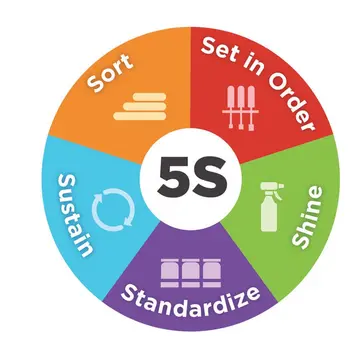Fix the root cause of No-Call No-Show with help from TeamSense
Productive employees, smoothly running machines, the highest quality products getting to clients on time…an efficient manufacturing line is a supervisor’s dream.
By definition, manufacturing efficiency focuses on producing as many products as you can while using the lowest possible amount of time, energy, and costs. This concept seeks to minimize waste in every step, but the larger picture extends beyond just production output. Achieving efficiency requires a strategic approach encompassing various facets of the manufacturing process.
In this post, we explore data-backed strategies that can help transform your operations and drive productivity to new heights. We will also explore the role of workplace organization, employee attendance, and employee training in manufacturing efficiency.
Let’s get going!
Why is Efficiency Important In Manufacturing?
“Smooth sailing” isn’t a phrase just for the open ocean. A smoothly-run, efficient manufacturing plant brings quite an array of benefits, including:
Improved quality: Efficiency can result in higher production rates and faster lead times. With more time available for quality control measures and thorough inspections, it becomes easier to maintain and enhance product quality.
Reduced costs: When a manufacturing process is more efficient, it requires less labor, materials, and energy—and therefore fewer expenses.
Increased profits: When efficient and sustainable, a manufacturing process can produce more products with the same amount of resources, which can lead to a significant increase in profits. A study by McKinsey found that when a company employed advanced data analysis to identify gaps in their production rate and increase efficiency, they increased their output by 18 to 30%.
Employee safety: An organized workspace with optimized processes reduces the likelihood of accidents, ensuring a safer working environment.
Manufacturing Efficiency vs. Manufacturing Productivity
Manufacturing efficiency involves streamlining operations to achieve maximum output with minimal input. It emphasizes utilizing resources wisely and reducing any unnecessary steps or delays in the production line. In contrast, manufacturing productivity solely gauges the number of goods produced within a specific timeframe, regardless of the resources employed. While high productivity can indicate a strong manufacturing capacity, it doesn't necessarily imply resources are used optimally.
Here's an illustration that explains the difference between manufacturing efficiency and manufacturing productivity. Let's say you like to peel potatoes, but you use a blunt knife every time you peel. This knife essentially gets the job done, but it also cuts out a large chunk of the potato flesh with the skin.
In this process, you’re productive because you’ve peeled potatoes successfully…but you’re not very efficient because you’re creating excess waste. So, you expend a lot of energy and time to get less output than you should. That is the central difference between efficiency and productivity.
Let’s see how we can get you to peel your potatoes better!
TL;DR Summary
What is Manufacturing Efficiency?Manufacturing efficiency involves producing the maximum number of products using the least amount of time, energy, and resources, aiming to minimize waste at every production stage.
Key Strategies to Improve Manufacturing Efficiency:
- Reduce Production Waste: Implement lean manufacturing principles to eliminate unnecessary materials and processes.
- Identify and Address Bottlenecks: Regularly analyze workflows to detect and resolve production slowdowns.
- Enhance Employee Attendance: Develop robust attendance policies to ensure consistent workforce presence.
- Automate Operations: Utilize technology to automate repetitive tasks, increasing speed and accuracy.
- Implement Manufacturing Software: Adopt tools for real-time monitoring and data analysis to optimize operations.
- Maintain Equipment Proactively: Schedule regular maintenance to prevent unexpected breakdowns.
- Provide Employee Training: Invest in continuous training to keep employees skilled and adaptable.
- Standardize Policies and Practices: Develop clear standard operating procedures to ensure consistency and quality.
Benefits of Improving Manufacturing Efficiency:
- Enhanced Product Quality: Allows for thorough quality control, leading to superior products.
- Cost Reduction: Efficient processes lower labor, material, and energy expenses.
- Increased Profit Margins: Higher output with the same resources boosts profitability.
- Improved Employee Safety: Organized and optimized workflows reduce workplace accidents.
Measuring Manufacturing Efficiency:Utilize Key Performance Indicators (KPIs) such as Overall Equipment Effectiveness (OEE), production yield, and cycle time to assess and monitor efficiency levels.
Enhance Efficiency with TeamSense:TeamSense offers tools to improve employee attendance and communication, crucial for maintaining a reliable workforce and minimizing downtime, thereby supporting overall manufacturing efficiency.
Key Takeaway:Implementing strategic measures to boost manufacturing efficiency leads to higher quality products, cost savings, and increased profitability. Leveraging solutions like TeamSense can play a pivotal role in achieving these goals.
How to Improve Manufacturing Efficiency
You’re already familiar with why efficiency is important in manufacturing, and how to know if you’re just producing, or producing efficiently. Comparing time, energy, and waste reduction to your output allows you to improve your manufacturing process and get the best out of your business.
Let’s have a look at some ways you can make this happen!
1. Reduce Production Waste
Production waste, also known as industrial waste or manufacturing waste, refers to any materials, substances, or by-products that are generated during the production or manufacturing process and are not part of the final product. Waste is often indicative of inefficiencies within the manufacturing process.
This waste is often discarded or considered unwanted because it doesn’t contribute to the intended product's value or function. To prevent waste, here are some actionable options to follow:
Conduct Regular Maintenance: Regular equipment checkups and maintenance prevent breakdowns, which result in wasted resources.
Implement Quality Controls: Stringent quality controls at each production stage can identify errors early on, preventing faulty products.
Training: Regular employee training helps ensure they're following best practices and reduces errors.

Another way to eliminate waste is by embracing lean manufacturing principles. Lean manufacturing principles originated in the Toyota Production System, and focuses on reducing waste in all forms. Here are a few principles and actionable ways to implement them:
Identify Value: Identify what provides value to the customer, then focus on these areas and reduce the time and resources spent on activities that do not add value.
Map the Value Stream: Understand the production flow from raw materials to the customer. This visualization can help you identify where waste occurs.
Create Flow: Once you've removed waste from the value stream, ensure your product flows smoothly through your production processes without delays or bottlenecks.
Establish Pull: Rather than producing large amounts of inventory in advance (push), produce only what the customer needs (pull). This reduces waste from overproduction and obsolescence.
Pursue Perfection: Continually strive for perfection by eliminating waste wherever it occurs. This is an ongoing, iterative process that requires a culture of continuous improvement.
Remember, lean manufacturing is about creating more value for customers with fewer resources. A lean organization understands customer value and focuses on key processes that continually meet those needs.
2. Identify Current or Potential Bottlenecks
Bottlenecks are points where the flow of production is restricted, leading to delays and inefficiencies. They can be caused by various factors such as outdated machinery, inefficient workstations, or lack of coordination among teams.
Bottlenecks can occur as both short-term bottlenecks and long-term bottlenecks. Short-term bottlenecks can be classified as minor inconveniences that don’t have a devastating effect on workplace efficiency when resolved immediately. An example of this is when you have an unplanned employee absence, but you have a shift management tool to re-fix the schedule.
However, long-term bottlenecks happen more frequently and have a larger impact on operations. For example, if your machinery constantly breaks down and needs repairs, you risk prolonged order delays and unhappy customers. Leaving these bottlenecks unaddressed can cause you to lose business and ultimately your profits.
Here’s how you can identify some bottlenecks hindering your efficiency:
Production Capacity and Utilization Analysis: One of the easiest ways to identify a bottleneck is to evaluate the capacity of each machine or process. If a single machine or process has lower throughput compared to the others, it may cause a bottleneck. In addition, analyze the utilization rate of each process. If one is constantly running at high utilization, there could be an issue.
Time Studies: You can perform time studies to measure how long it takes for a task to be completed at each stage of the production process.
Work-in-Process (WIP) Inventory Levels: High levels of WIP inventory are often a clear sign of a bottleneck: if there’s a stage in the production process where items are consistently waiting to be processed, this could be an area for improvement.
Use the “5 whys” technique: To find the root cause of a bottleneck, ask "why" five times, and delve deeper with each question. The 5 whys technique helps pinpoint the true cause of the bottleneck, whether it's a supplier issue, work center problem, or other underlying factors.

3. Improve Employee Attendance
Improving employee attendance plays a crucial role in reducing downtime, optimizing workforce allocation, and maintaining a consistent production schedule. With solutions in place to mitigate its effects, employee absence may be considered a short-term bottleneck. However, without proper solutions or plans, employee absence can lead to major problems.
A study reveals that absenteeism costs U.S. employers $225.8 billion every year–that’s a high number! These costs also come with decreased output and overall inefficiency in the production line since absenteeism directly affects other employees and managers who have to cover open shifts. When trying to cover for absences, employees experience a 29.5% reduction in productivity while managers experience a 15.7% decrease.
To combat the effect of employee absenteeism, manufacturing teams are adopting powerful solutions that enable them to stay ahead of the problem. We’re proud that one of these solutions is TeamSense.
TeamSense is an absence management software that helps automate attendance tracking and reduce employee absenteeism. Your employees don’t need to find their way around complex apps before they can get to the manager. All they have to do is send a text to a company number and fill out a short mobile survey, and their manager is notified instantly.

Our platform’s user-friendly features empower both managers and employees to work together to prevent miscommunication and increase efficiency in the workplace.
To ensure that no one is absent more than they should be, managers can also monitor time-off patterns and employee trends with accurate data. Employees have access to an employee portal that keeps them up-to-date with company procedures and guidelines.
4. Automate Operations When Possible
Automation in manufacturing refers to the use of technology, robotic process automation, and computer-controlled systems to perform tasks and processes often carried out manually.
Automation minimizes the risk of human error and speeds up manual processes. It involves the integration of machines and software to automate various stages of the manufacturing process, from raw material handling to inventory management and final product assembly.
Automation helps free up valuable time for your employees and prevent burnout. Energized, productive employees are one of the main ingredients of an efficient manufacturing system.
5. Use Manufacturing Software
Manufacturing involves a lot of moving parts that have to work together – literally and figuratively. Fortunately, there’s great software for manufacturers that can streamline different production processes, including:
Production planning
Customer relationship management
Workforce management
Inventory management
Enterprise resource planning
Supply chain management
6. Stay Organized
A survey by Brother International reveals that 31% of employees experience elevated stress in disorganized workplaces, while 52% find tidiness enhances productivity.
Efficient organization in manufacturing plants includes planning layouts to prevent workspace and equipment inefficiencies. Implementing the 5S methodology also helps promote orderliness. The 5S methodology is a systematic approach to workplace organization and cleanliness aimed at creating a safe, productive, and efficient work environment.

5S stands for:
Sort: Remove unnecessary items from the workspace. Keep only essential tools and materials to avoid clutter.
Set in Order: Organize the remaining items and assign specific locations for tools and materials to make them easy to find and use.
Shine: Clean and maintain the workspace regularly. Ensure tidiness is upheld to create a safe and pleasant environment.
Standardize: Establish consistent practices and procedures for the 5S methodology. Use visual cues and signs to maintain order and standardization across the workplace.
Sustain: Make 5S a daily habit and continuously improve the system. Encourage employee involvement and ownership to sustain the gains achieved through the 5S process.
6. Avoid Equipment Breakdowns
If you’re running a manufacturing line, you’ve likely run into some sort of equipment breakdown, perhaps from:
Mechanical failure: This can be due to a production defect from the manufacturer or incorrect use of the machine by employees.
Thermal failure: When a machine gets too hot, it could heat the metal components and cause damage.
Overload: It’s important to consider the equipment's capacity in order to prolong its lifespan.
Contaminated oils or low lubrication: Re-used oils may contain dirt, metal scraps, water, and chemicals that hinder it from performing optimally. Insufficient lubrication also causes parts to grind against each other, causing wear and tear.
To mitigate equipment breakdowns, it’s helpful to prioritize preventive maintenance. Predictive data analytics leverages industrial IoT-enabled sensors and edge computing to alert your team about potential issues before they disrupt productivity. Regularly inspecting and maintaining machinery can help identify and address potential issues before they escalate to major breakdowns.
7. Offer Employee Training
Interactive and hands-on training is highly effective for manufacturing employees. It surpasses traditional text and audio-based methods because it is more engaging, enhances knowledge retention, and allows employees to practice skills in a safe environment. As manufacturing processes become more technologically advanced, practical training becomes crucial for employees to handle complex machinery.
A great employee training program won’t just teach employees how to handle the latest technology and equipment but will also ensure they stay up-to-date with company procedures like attendance policies and safety guidelines.
Providing access to clear job expectations, mentorship, compliance training, and career growth options are also essential to ensuring engaged and productive employees. A report by Gartner reveals that employers that keep their employees engaged see a 21% increase in high performance. Another study by People Element shows employee engagement activities enable workforces to see 43% less absenteeism, 64% fewer accidents, and 68% higher well-being.
Training and retaining your employees saves your business the costs it would take to recruit fresh hires. When equipped with the right skills and motivation, employees can reach new heights in productivity and efficiency, contributing to the success of the organization.
8. Standardize Your Policies & Best Practices
In a competitive market, businesses need to go above and beyond to meet customer expectations by offering high-quality products with long-lasting value. Standardizing best practices and policies ensures consistent and predictable product quality, which reduces variations and improves reliability. Regulating quality control procedures also enables consistent inspections and early detection of defects, preventing faulty products from reaching customers.
Here are some ways you can standardize your policies and best practices:
Document processes: Create guidelines that outline steps required to complete different tasks. You can do this using flowcharts, process maps, or checklists.
Identify what works: Observe your high performers and test their processes throughout the operation. Implement if successful and use data analysis and customer feedback to refine.
Train employees: Carry out workshops and periodic drills to keep employees familiar with company procedures.
Track and measure results: Establish Key Performance Indicators (KPIs) and set them as benchmarks against employee performance. Incorporate data analytics to get more insights and areas for improvement.
By using cohesive and systematic approaches, all manufacturing locations can optimize costs and product quality in a way that is measurable and repeatable.
How to Calculate Manufacturing Efficiency
We never said improving manufacturing efficiency was simple—and those are a lot of strategies to work on. But before we wrap up, we need to share how to calculate manufacturing efficiency so you can tell if your efforts are working.
This is the manufacturing efficiency formula:
Manufacturing Efficiency = (Actual Output / Standard Output) x 100%
Here, 'Actual Output' refers to the real quantity of goods or units that your manufacturing process produces in a given period. 'Standard Output', is the maximum quantity of goods or units that could theoretically be produced in the same period, assuming perfect efficiency.
By accurately calculating this efficiency metric, you can identify your operational effectiveness and discern how far it deviates from an ideal score of 100%. This provides insight into potential areas of improvement and helps quantify the effort required to boost your efficiency to yield better outcomes.
For instance, if your manufacturing facility produces 800 units in a day while it can produce 1000 units (in ideal conditions), then your manufacturing efficiency would be (800/1000) x 100 = 80%. This signifies there's room for a potential 20% increase in efficiency.
Manufacturing KPIs & Metrics to Know
In addition to the standard formula, some different KPIs and metrics can help evaluate efficiency, quality, and overall performance. Here are some important ones to keep an eye on:
1. Machine Downtime Rate: This measures the percentage of total time that a machine is unavailable due to breakdowns or scheduled maintenance.
Machine Downtime Rate = (Downtime / Total Time) x 100%
2. Percentage Planned Maintenance: This shows the proportion of maintenance activities that are planned ahead versus reactive tasks.
Percentage Planned Maintenance = (Planned Maintenance Time / Total Maintenance Time) x 100%
3. Downtime to Operating Time: This measures the ratio of downtime to operating time, providing a measure of process reliability.
Downtime to Operating Time = (Downtime / Operating Time) x 100%
4. Capacity Utilization: This measures how much of the total manufacturing output capacity is being utilized at a given point in time.
Capacity Utilization = (Actual Output / Maximum Possible Output) x 100%
5. First Pass Yield (FPY): This is the percentage of products produced that meet quality standards without the need for rework.
First Pass Yield = (Number of Good Units / Total Units Produced) x 100%
6. Overall Equipment Effectiveness (OEE): This is a multiplication of Availability, Performance, and Quality. It measures the overall efficiency of machinery and equipment. The higher your OEE, the more effective your equipment is. A score of 100 percent means you are manufacturing 100 percent of the time, at 100 percent capacity, at a 100 percent yield (no defective parts).
OEE = Availability x Performance x Quality
7. Manufacturing Cost Per Unit: This shows the total cost to produce one unit of product.
Manufacturing Cost Per Unit = Total Manufacturing Cost / Total Units Produced.
8. Material Yield Variance: This calculates the difference between the actual amount of material used and the standard amount expected to be used.
Material Yield Variance = (Actual Material Used - Standard Material Expected) x Standard Cost Per Unit
9. Maintenance Cost Per Unit: This shows the cost of maintaining equipment for each unit of product produced.
Maintenance cost per unit = Total Maintenance Cost / Total Units Produced
10. Overtime Rate: This measures the percentage of total overtime hours worked, which could indicate capacity issues.
Overtime rate= Overtime Hours / Total Hours Worked) x 100%
Improve Your Manufacturing Efficiency with TeamSense
The benefits of running an efficient manufacturing business are vast, from increased productivity and reduced costs to improved product quality and sustainability. While improving different production processes may require time and effort, the long-term payoff is substantial. Businesses that prioritize efficiency not only gain a competitive edge but also cultivate a culture of innovation and adaptability.
If you’re looking for support in improving your manufacturing efficiency, consider using TeamSense as your solution. With our data-driven workforce management platform, we help your team manage attendance, optimize shift scheduling, and facilitate seamless communication.
We’ve helped companies achieve a 39% reduction in employee absenteeism—that's to 100% adoption and 48-hour rollouts.
Let TeamSense help you with this part of the manufacturing efficiency puzzle!
About the Author

Sheila Stafford, CEO | Leader in Applied AI for Frontline Productivity
As CEO of TeamSense, Sheila Stafford is at the forefront of increasing productivity for frontline teams through AI-driven solutions. Her visionary approach combines cutting-edge technology with a thoughtful focus on enhancing human connection; Sheila strategically implements AI where it adds the most value while recognizing the critical role of personal interaction and ensuring that human engagement remains central when it matters most. Under her leadership, TeamSense is redefining how companies support and engage their frontline teams for a more connected, efficient workplace.

